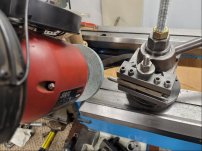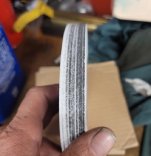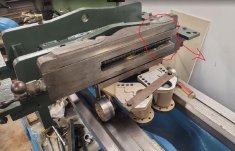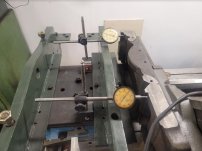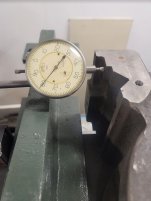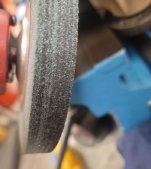I have often considered doing this to my lathe, but I have never been able to figure out how to do the full length of the bed. In every way I have considered, I could grind all but about 18" of the bed, but the sled would prevent me from grinding the portion under the sled and away from the grinding wheel. What is your solution?
Great question. The sled currently rides on tail stock ways. We can't grind TS ways, while still using those ways as our guiding path. I have a solution, but it won't be in the manner that the manufacture, nor a specialized grinding shop may do.
I should mention that I am not intending to grind tail stock vee way. I do intend to grind the TS flat way though, as it got tore up from that short section on carriage. I'm also grinding carriage flat way. And the two unused flats on each bed rail, those two simply for looks, as someone thought they'd make a great anvil:
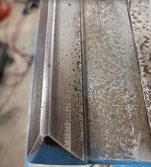
Looking at an old pic for visual aid. Carriage vee way is 88" long on mine. If measuring that 88" from TS end toward headstock, we know the carriage itself can not reach the full 88" end on headstock side, its stops several inches short.
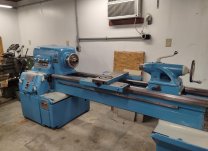
So for carriage itself, I dont need to grind the full length of bed on the carriage flat way. For carriage flat way, I will measure 88" from TS end, and mark that carriage flat way adjacent to carriage vee way, on other side of headstock.
Problem. With surface grinding, the grinding wheel can not start in the middle of the work, nor reverse course in the middle of a pass. The grinding wheel must start before touching the work, and finish its pass off the work.
Solution: A relief must be cut so that wheel can start(or finish a pass) without touching work. In the case of carriage flat way, I think carriage flat way needs to be ground .015"-.020". Measuring from TS end, I will grind a relief between the 88" and 90" mark. I will grind that 2" relief about .025"-.030" deep. The wheel will start inside the relief as I begin to make my passes for carriage flat.
Now on toward your real question, the tail stock ways. . . A little more complicated, but requires the same solution. Relief cuts.
Knee jerk reaction, the end solution may not seem as desirable. But if you really consider the difference between what the carriage does, and what the tail stock does, this will be very effective.
Difference between carriage and tail stock operation. Carriage carries the tool tip, its flow and movement must be smooth and have perfect symmetry, or the results will transfer to the work being cut. Luckily, we have no reliefs cut in the total path of carriage, so it will have this symmetry. Tail stock does not need this so much. Tail stock is moved and locked down. What we need is tail stock to have consistent height and alignment to headstock spindle. So a relief cut somewhere in its operational path won't matter to the actual work, as long as the TS way maintains the TS height and alignment.
Cutting TS ways can not be done using TS base, nor using the same ways you are cutting. To cut TS ways we must use carriage and carriage ways, transferring grinder to carriage.
Problem. Carriage has limited range/reach in both directions. And if mounting grinder to carriage to either headstock side or tailstock side, we can not complete a full uninterrupted pass of TS ways.
Solution. Don't grind TS ways under head stock, plus we will need to cut two reliefs.
The first relief will be directly in front of headstock mounting. With head stock removed, we can see the tattoo mark where it sat. First relief cut there. Its under chuck, and with lathe complete, tail stock itself can not physically reach this first relief cut anyway. Note the line in front of bolt hole, thats where first relief cut will begin:
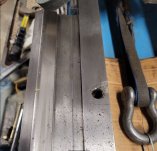
Unfortunately, the second relief will need to be cut in the path of TS operation. To accomplish grinding TS ways, the grinder will need to be mounted on TS side of carriage first. A short section ground at TS end of bed. Then grinder swapped toward headstock side of carriage, where the longer uninterrupted grinding path will be ground from relief at headstock to the relief I need toward the TS end. Carriage is 25" in wing span. I need to actually set up grinder on carriage to know an exact number, but I suspect the second relief to be cut somewhere at 24"-30" from end of bed on TS end. *Edit: That 2nd relief serves double duty. Its the grinder starting point for working short section at TS end of bed. And the stopping point from headstock toward TS end.
I will attempt to keep that relief short, maybe 1" long. Also the depth of second relief to within .001". Example, if I need to remove .015" from TS way. I will try to cut depth of relief to .0155"-.016".
Upon total lathe completion, this will leave a 1" section, .001" lower than the rest of TS way. As the bed is long, most of my TS operation will occur past that mark and toward head stock anyway. If I have to cross that section, or even lock TS down over it, so what ? It won't affect actual operation, as I will have ground way to the same height, to either side of the 2nd relief. It'll be a minor blemish which I can live with. I may fill that 1" blemish/low spot with epoxy.




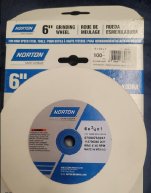
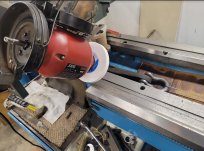
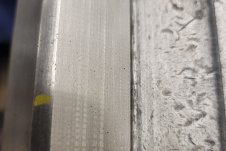
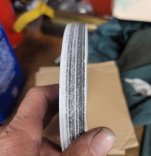
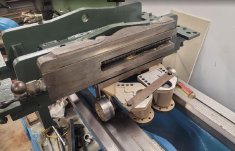
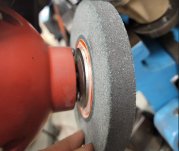
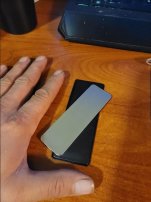

 .
.